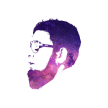The Future of Motion Graphics Design
Nobody Knows

Introduction to Motion Graphics Design (The Power of Visual Storytelling)
Motion graphics design is a creative field that combines elements of graphic design and animation to create captivating visual experiences. It is an effective medium for conveying complex information, ideas, and narratives in a concise and engaging manner. By incorporating movement, typography, and imagery, motion graphics designers can communicate messages more effectively, capturing the viewer's attention and leaving a lasting impression.
Current Trends in Motion Graphics Design
The field of motion graphics design is constantly evolving, driven by technological advancements and creative experimentation. Some of the current trends in motion graphics design include:
Minimalism and Flat Design: Clean and simplified visual styles that focus on essential elements and minimalistic aesthetics.
To implement this trend, utilize simple shapes, bold colors, and clean typography.
Kinetic Typography: Animated text that moves and reacts to enhance the message and visual appeal.
To achieve kinetic typography, animate text elements using keyframe animations or typography plugins.
3D Animation: Three-dimensional elements and environments that add depth and realism to motion graphics.
To create 3D animations, utilize software like Cinema 4D or Blender and learn the basics of modeling, lighting, and rendering.
Data Visualization: Transforming complex data into visually compelling and easily understandable graphics.
To create data visualizations, use tools like Adobe After Effects or Tableau, and consider using charts, graphs, or infographics.
The Impact of Technology on Motion Graphics
Technology plays a crucial role in shaping the future of motion graphics design. Advancements in software, hardware, and interactive technologies have opened up new possibilities for designers to push creative boundaries. Here are some ways technology is impacting motion graphics:
Artificial Intelligence (AI): AI-powered tools automate repetitive tasks, streamline workflows, and enhance creativity.
Embrace AI-powered plugins or applications that offer features like auto-animation, content-aware fill, or style transfer.
Virtual Reality (VR) and Augmented Reality (AR): Immersive technologies that enable users to experience motion graphics in a new dimension.
To create VR or AR motion graphics, explore platforms like Unity or Unreal Engine and integrate motion graphics with the interactive experience.
Real-time Rendering: Rendering techniques that allow designers to view and adjust their work instantly, speeding up the creative process.
Utilize real-time rendering engines like Unreal Engine or Adobe Aero to visualize motion graphics in real-world contexts.
Motion Capture: Techniques that capture real-life movements and apply them to digital characters or objects.
Experiment with motion capture suits, sensors, or software like Mixamo to bring realistic movements to your motion graphics.
Future Possibilities: Interactive and Immersive Experiences
The future of motion graphics design holds exciting possibilities for creating interactive and immersive experiences. Here are some concepts to explore:
Interactive Motion Graphics: Designing motion graphics that respond to user input, allowing for personalized and engaging interactions.
Incorporate user interface elements, interactive buttons, or gesture-based controls to enhance user engagement.
Holographic Displays: Creating motion graphics that interact with holographic displays, adding depth and realism to visual experiences.
Collaborate with developers and explore holographic technologies, such as Microsoft's HoloLens or Magic Leap, to bring motion graphics to life.
Spatial Design: Blending motion graphics seamlessly with physical spaces, creating dynamic environments and captivating installations.
Experiment with projection mapping, LED screens, or immersive installations to integrate motion graphics with physical surroundings.
Motion Graphics in Web Design
Motion graphics have become an integral part of modern web design, adding dynamism and visual interest to websites. Consider the following tips for incorporating motion graphics into web design:
Loading Animations: Create animated loading screens or progress bars to provide feedback and engage users during page loading.
Use CSS animations or JavaScript libraries like Lottie or GSAP to add loading animations to your web pages.
Microinteractions: Small, subtle animations that respond to user interactions, enhancing the overall user experience.
Apply micro-interactions to elements like buttons, hover effects, or form validation to provide visual feedback and improve usability.
Storytelling Through Scrolling: Utilize parallax effects, scroll-triggered animations, or animated transitions to guide users through a narrative.
Use libraries like Scroll Magic or Scroll Reveal to create scroll-driven animations and transitions that enhance storytelling.
Conclusion
The future of motion graphics design is brimming with opportunities for creativity, innovation, and immersive experiences. As technology continues to advance, motion graphics designers can push the boundaries of visual storytelling, engage audiences on a deeper level, and create memorable experiences that leave a lasting impact. Embrace emerging trends, leverage new technologies, and continue exploring the ever-evolving field of motion graphics design.
About the Creator
Abul Kalam Azad
Hi, I'm abul kalam azad! I'm a motion designer sharing my thoughts on motion design with the vocal media community. Follow me for insights and experiences.






Comments
There are no comments for this story
Be the first to respond and start the conversation.